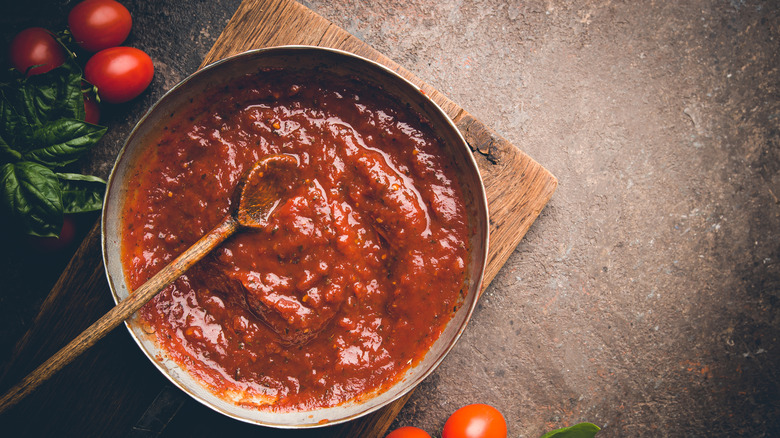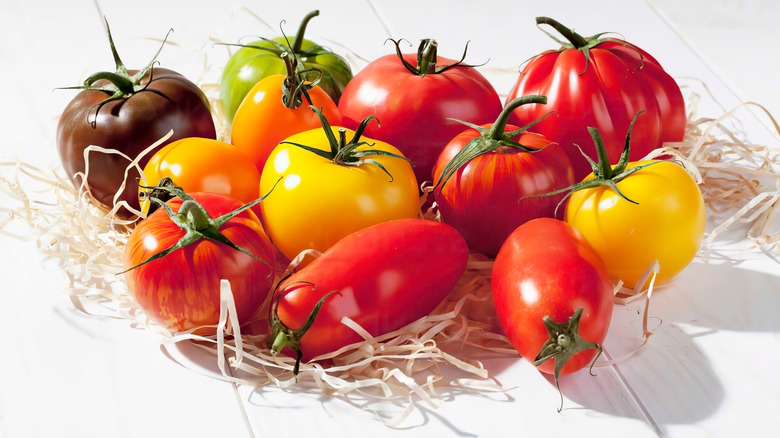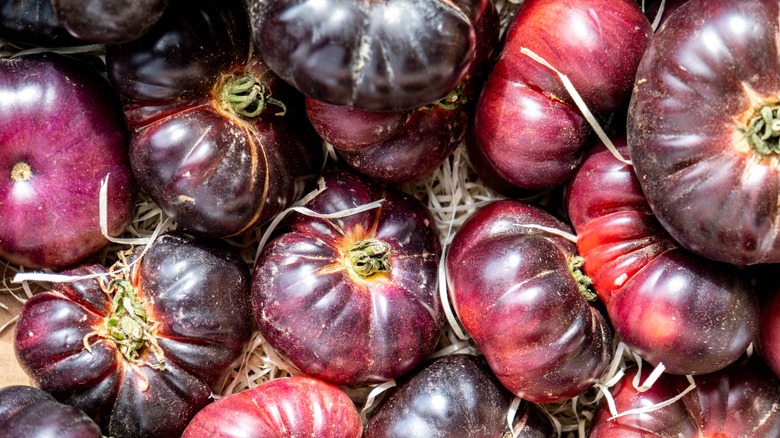What Mixing Tomato Colors Does To Tomato Sauce
Unless you're going Deep South with a recipe like "fried green tomatoes," those vine-ripened tomato darlings of late summer should be red, or so says conventional wisdom. But convention has a long arm, one that sweeps across the world with its own characteristics and inclinations. So shake loose of your culinary preconceptions when it comes to tomatoes, especially when creating a rich, delectable, fresh tomato sauce. Color matters, but not purely for aesthetic reasons.
Picture someone stirring a bubbling pot of homemade marina sauce, and what do you see? The color red, of course, is derived from a bright array of diced and crushed Roma, Cherry, Plum, Pachino, San Marzano, or hundreds of Italian tomatoes varietals, known in Italian as "pomo d'oros," according to Eataly. However, the saucy red potion brewing in that magic kitchen pot doesn't always come from a single color scheme. Tomatoes parade across fields and farmhouses cloaked in shades ranging from yellow to orange, pink, purple, black, and varying mixed hues. There's even a sassy striped tomato, appropriately named "Mr. Stripey," notes Bonnie Plants. When making tomato sauce, there's a way to balance flavor, texture, and tangy tartness with a simple technique — and it's all about mixing tomato colors.
Color wheel of tasty fortune
Each tomato taps to its own rhythm, growing slowly or ripening quickly, on the vine or in the sun, dropping at the first hint of maturation or clinging on through the cool, crisp breezes of early autumn. Regardless of how those juicy tomatoes end up in your kitchen, the colors they are define the sauces you create. In general, the exterior color of a tomato offers a hint of the flavor inside, allowing you to mix and match tomatoes for the perfect balance of acidity, sweetness, and flavor depth.
Red tomatoes provide the ultimate, traditional base of a hearty tomato sauce, offering plenty of juice and enough tanginess to tickle the tastebuds, explains Bonnie Plants. From there, you can tweak to taste. Livestrong recommends adding orange or yellow tomatoes to red ones in a half-and-half ratio per batch of sauce. This preserves the classic red color while reducing any harsh acidic tones. For a slightly sweet touch, toss in some pink tomato varieties such as Pink Brandywine, Martha Washington, or Bradley, which tend to be milder.
Go rich and bold
Taking things to an experimental stage requires less common color partners such as black or purple tomatoes. Described as rich and complex by Home for the Harvest, they're prized by professional chefs for the rich, sometimes smoky flavor profiles. Purple tomatoes may be hard to find in local supermarkets or farmer stands, but that could be changing soon. A new genetically-modified purple variety may be available by 2023; one that's high in antioxidants and has a longer-than-average shelf life, per CNN. The purple colorization comes from the antioxidants, which is a result of engineering that incorporates genes from snapdragon plants, reveals Norfolk Plant Sciences.
As for the spunky Mr. Stripey and his multi-hued counterparts, add them to your tomato sauce for a bold, fruit-forward, low-acid creation. It's all about personal preference, but don't box yourself in — go bold and spoon that goodness over your pizzas, lasagnas, and penne, capellini, bucatini, ziti, and dozens more preferred pasta dishes.


